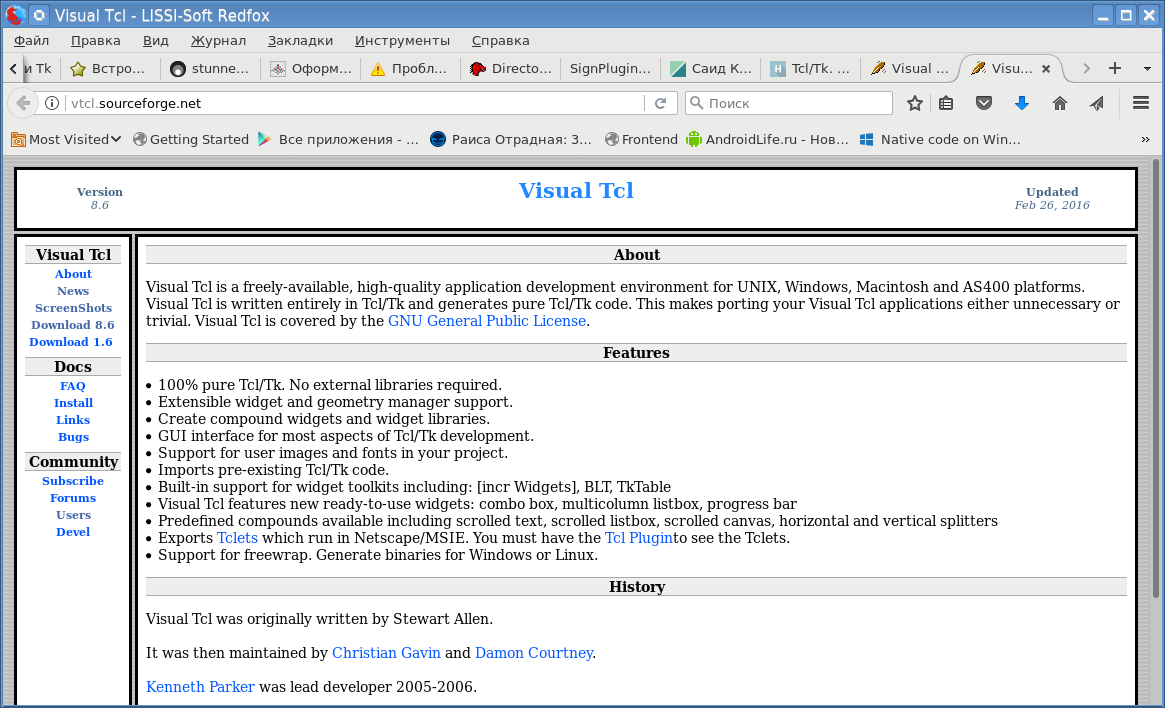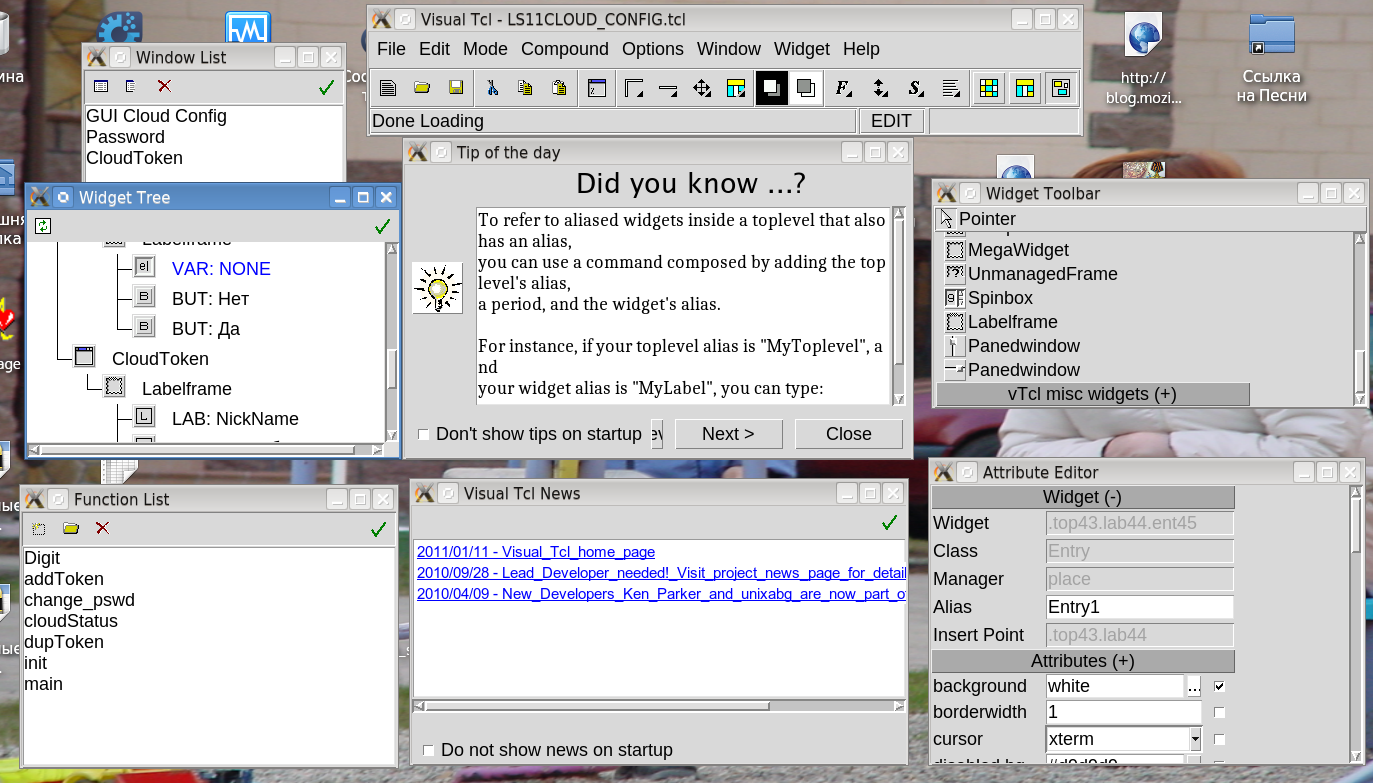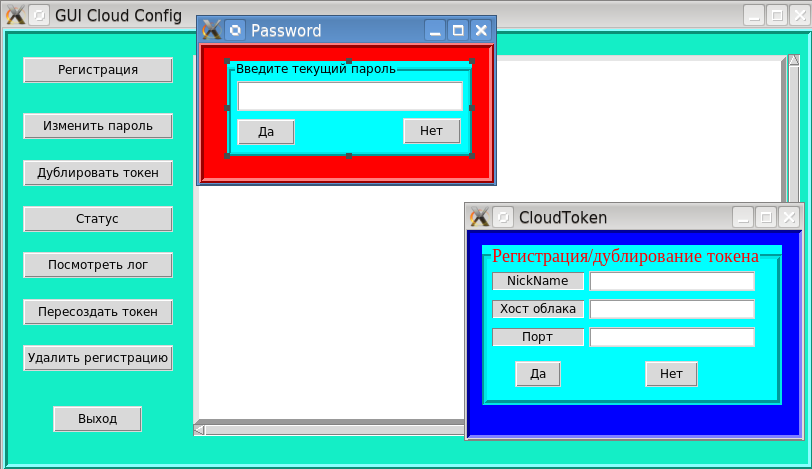Visual Tcl. Developing a graphical user interface for command line utilities (Continued)
In the previous article, the tkBuilder constructor was considered as a toolkit for creating a graphical interface for command-line utilities based on Tcl / Tk. The constructor is good, but as noted in the article, it also has a number of drawbacks, the main one of which is the lack of support for UTF-8, and therefore the Russian alphabet. Another drawback was noted by user merlin-vrn . This support is currently only Tcl / Tk version 8.4.
But here in the comment from the user svk28 the Tck / Tk-based Visual Tcl constructor was mentioned:

After a preliminary acquaintance, it was decided to use it in practice, especially since the previous material actually remained incomplete if you look at it from the point of view of its declared goal - to give a graphical shell to command-line utilities with which you can access the PKCS # 11 cloud token. Therefore, it is time to develop a graphical interface for the second utility, namely ls11cloud_config:
The first step was to check which version of Tcl / Tk supports Visual Tcl. It turned out that version 8.6, which is installed on my computer, is supported by the Visual Tcl constructor:
The first launch of the designer was not inspired, too many windows appeared on the desktop:

But looking around it turned out that a couple of windows (news feed - Visual Tcl News and did you know it - Did you know) can be closed without any damage to the work. And it turns out that there are already not so many windows and, if necessary, they can be periodically hidden.
A pleasant surprise was the presence of its own easel for each widget of the toplevel class:

In our project, we needed three widgets of the toplevel class and, accordingly, we had three easels:
1. GUICloudConfig widget, the main window with the ls11cloudconfig utility functions (see above);
2. Password widget, which is somehow involved in all functions:

3. CloudToken widget, which is used in the functions of Registration and Duplication of a cloud cryptographic token:

And no problems with the "great, powerful, truthful and free Russian language!" (I.S. Turgenev).
Note one feature of the Visual Tcl designer. It is associated with editing features. Changes to the functions will not get into the project until the window in which the function is edited is closed:

We also note that the project in the understanding of Visual Tcl is saved as a Tcl / Tk file (* .tcl) and it is at any time can be performed independently without additional transformations. The converse is not true, far from every Tcl / Tk file constructor will consider as its own project.
Visual Tcl project led to another very useful thing - the ability to save the project in binary code. For this purpose, the freewrap utility is used , which turns Tcl / Tk scripts into single-file executable programs. So we both converted scripts that implement the GUI for p11conf and ls11cloudconfig utilities into executable programs:
Now we just have to pack and lay out everything (projects, tcl-scripts and executable programs) for free use. Download distributions for Linux / OS X (macOS) / Windows platforms here:

Many thanks to svk28 for his help!
But here in the comment from the user svk28 the Tck / Tk-based Visual Tcl constructor was mentioned:

After a preliminary acquaintance, it was decided to use it in practice, especially since the previous material actually remained incomplete if you look at it from the point of view of its declared goal - to give a graphical shell to command-line utilities with which you can access the PKCS # 11 cloud token. Therefore, it is time to develop a graphical interface for the second utility, namely ls11cloud_config:
bash-4.3$ /usr/local/bin64/ls11cloud_config
LS11CLOUD User Utility
usage: /usr/local/bin64/ls11cloud_config ] [-n ]
Commands:
register - register new user on the server
duplicate - duplicate user account on other computer
change_pswd - change SESPAKE authentication password
status - display current configuration data
log - display server log file
recreate - re-create token to initial empty state
unregister - remove all user files from the server
NB: Don't use non-latin letters to avoid encoding problems!
bash-4.3$ The first step was to check which version of Tcl / Tk supports Visual Tcl. It turned out that version 8.6, which is installed on my computer, is supported by the Visual Tcl constructor:
bash-4.3$ cd ../vtcl.vtcl-8.6-master
bash-4.3$ ./configure
Using /bin/wish8.6
bash-4.3$The first launch of the designer was not inspired, too many windows appeared on the desktop:

But looking around it turned out that a couple of windows (news feed - Visual Tcl News and did you know it - Did you know) can be closed without any damage to the work. And it turns out that there are already not so many windows and, if necessary, they can be periodically hidden.
A pleasant surprise was the presence of its own easel for each widget of the toplevel class:

In our project, we needed three widgets of the toplevel class and, accordingly, we had three easels:
1. GUICloudConfig widget, the main window with the ls11cloudconfig utility functions (see above);
2. Password widget, which is somehow involved in all functions:

3. CloudToken widget, which is used in the functions of Registration and Duplication of a cloud cryptographic token:

And no problems with the "great, powerful, truthful and free Russian language!" (I.S. Turgenev).
Note one feature of the Visual Tcl designer. It is associated with editing features. Changes to the functions will not get into the project until the window in which the function is edited is closed:

We also note that the project in the understanding of Visual Tcl is saved as a Tcl / Tk file (* .tcl) and it is at any time can be performed independently without additional transformations. The converse is not true, far from every Tcl / Tk file constructor will consider as its own project.
Visual Tcl project led to another very useful thing - the ability to save the project in binary code. For this purpose, the freewrap utility is used , which turns Tcl / Tk scripts into single-file executable programs. So we both converted scripts that implement the GUI for p11conf and ls11cloudconfig utilities into executable programs:
bash-4.3$ ls
GUITKP11Conf.tcl LS11CLOUD_CONFIG.tcl
bash-4.3$
bash-4.3$ freewrap GUITKP11Conf.tcl
bash-4.3$ freewrap LS11CLOUD_CONFIG.tcl
bash-4.3$ ls
GUITKP11Conf LS11CLOUD_CONFIG
GUITKP11Conf.tcl LS11CLOUD_CONFIG.tcl
bash-4.3$Now we just have to pack and lay out everything (projects, tcl-scripts and executable programs) for free use. Download distributions for Linux / OS X (macOS) / Windows platforms here:

Many thanks to svk28 for his help!
